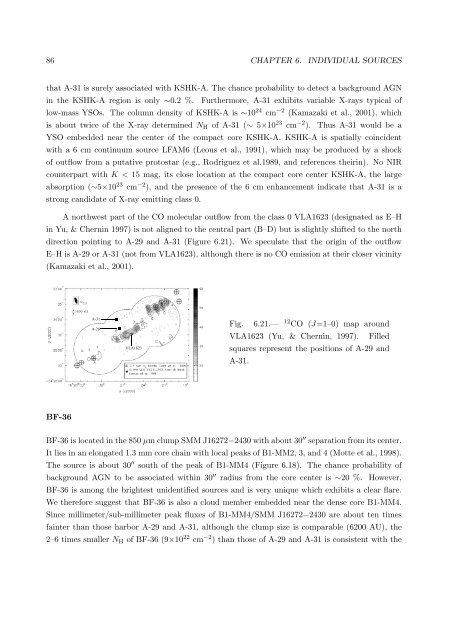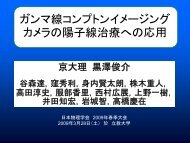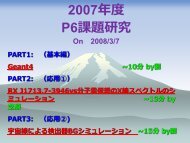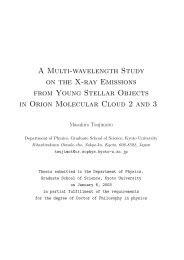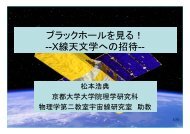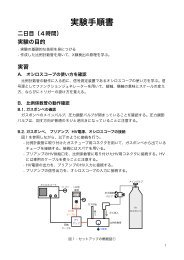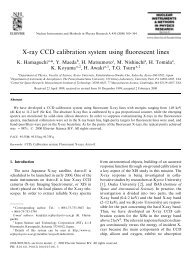86 CHAPTER 6. INDIVIDUAL SOURCESthat A-31 is surely associated with KSHK-A. The chance probability to detect a background AGN<strong>in</strong> <strong>the</strong> KSHK-A region is only ∼0.2 %. Fur<strong>the</strong>rmore, A-31 exhibits variable X-<strong>ray</strong>s typical <strong>of</strong>low-<strong>mass</strong> YSOs. The column density <strong>of</strong> KSHK-A is ∼10 24 cm −2 (Kamazaki et al., 2001), whichis about twice <strong>of</strong> <strong>the</strong> X-<strong>ray</strong> determ<strong>in</strong>ed N H <strong>of</strong> A-31 (∼ 5×10 23 cm −2 ). Thus A-31 would be aYSO embedded near <strong>the</strong> center <strong>of</strong> <strong>the</strong> compact core KSHK-A. KSHK-A is spatially co<strong>in</strong>cidentwith a 6 cm cont<strong>in</strong>uum source LFAM6 (Leous et al., 1991), which may be produced by a shock<strong>of</strong> outflow from a putative protostar (e.g., Rodriguez et al.1989, and references <strong>the</strong>ir<strong>in</strong>). No NIRcounterpart with K < 15 mag, its close location at <strong>the</strong> compact core center KSHK-A, <strong>the</strong> largeabsorption (∼5×10 23 cm −2 ), and <strong>the</strong> presence <strong>of</strong> <strong>the</strong> 6 cm enhancement <strong>in</strong>dicate that A-31 is astrong candidate <strong>of</strong> X-<strong>ray</strong> emitt<strong>in</strong>g class 0.A northwest part <strong>of</strong> <strong>the</strong> CO molecular outflow from <strong>the</strong> class 0 VLA1623 (designated as E–H<strong>in</strong> Yu, & Chern<strong>in</strong> 1997) is not aligned to <strong>the</strong> central part (B–D) but is slightly shifted to <strong>the</strong> northdirection po<strong>in</strong>t<strong>in</strong>g to A-29 and A-31 (Figure 6.21). We speculate that <strong>the</strong> orig<strong>in</strong> <strong>of</strong> <strong>the</strong> outflowE–H is A-29 or A-31 (not from VLA1623), although <strong>the</strong>re is no CO emission at <strong>the</strong>ir closer vic<strong>in</strong>ity(Kamazaki et al., 2001).Fig. 6.21.— 12 CO (J=1–0) map aroundVLA1623 (Yu, & Chern<strong>in</strong>, 1997). Filledsquares represent <strong>the</strong> positions <strong>of</strong> A-29 andA-31.BF-36BF-36 is located <strong>in</strong> <strong>the</strong> 850 µm clump SMM J16272−2430 with about 30 ′′ separation from its center.It lies <strong>in</strong> an elongated 1.3 mm core cha<strong>in</strong> with local peaks <strong>of</strong> B1-MM2, 3, and 4 (Motte et al., 1998).The source is about 30 ′′ south <strong>of</strong> <strong>the</strong> peak <strong>of</strong> B1-MM4 (Figure 6.18). The chance probability <strong>of</strong>background AGN to be associated with<strong>in</strong> 30 ′′ radius from <strong>the</strong> core center is ∼20 %. However,BF-36 is among <strong>the</strong> brightest unidentified sources and is very unique which exhibits a clear flare.We <strong>the</strong>refore suggest that BF-36 is also a cloud member embedded near <strong>the</strong> dense core B1-MM4.S<strong>in</strong>ce millimeter/sub-millimeter peak fluxes <strong>of</strong> B1-MM4/SMM J16272−2430 are about ten timesfa<strong>in</strong>ter than those harbor A-29 and A-31, although <strong>the</strong> clump size is comparable (6200 AU), <strong>the</strong>2–6 times smaller N H <strong>of</strong> BF-36 (9×10 22 cm −2 ) than those <strong>of</strong> A-29 and A-31 is consistent with <strong>the</strong>
6.5. NEW YSO CANDIDATES – A-29, A-31, AND BF-36 87embedded star scenario.Consider<strong>in</strong>g that N H <strong>of</strong> BF-36 is ra<strong>the</strong>r typical <strong>of</strong> those <strong>of</strong> class I sources (see Figure 7.3), itis located at ra<strong>the</strong>r <strong>of</strong>f-center position, and a class II source GY238 (BF-33) is closer to <strong>the</strong> center<strong>of</strong> SMM J16272−2430, BF-36 would be a more evolved star than <strong>the</strong> class 0 stage, possibly classI or II. Assum<strong>in</strong>g <strong>the</strong> average ratio <strong>of</strong> < L X >/L bol to be 10 −4.0 <strong>in</strong> <strong>the</strong> quiescent phase for YSOs(§7.4.2) and us<strong>in</strong>g N H <strong>of</strong> 9×10 22 cm −2 , L bol and A V <strong>of</strong> BF-36 are expected to be ∼0.8 L ⊙ and∼60 mag (§7.4.1). These are above <strong>the</strong> current detection limit; some NIR-detected sources havenearly <strong>the</strong> same values (see Figure 7.1). One possibility <strong>of</strong> no NIR counterpart is that BF-36 is aYSO with very active X-<strong>ray</strong>s. Assum<strong>in</strong>g < L X >/L bol <strong>of</strong> ≈10 −3.5 , we <strong>the</strong>n expect L bol <strong>of</strong> 0.08 L ⊙ ,which is below or near <strong>the</strong> current detection limit (Figure 7.1).6.5.5 Ionization effect to circumstellar materialsThe flare lum<strong>in</strong>osity and duty ratio <strong>of</strong> A-29, A-31, BF-36 are ∼10 30 ergs s −1 and roughly one per100 ks, respectively. Due to <strong>the</strong> large absorption, a significant fraction <strong>of</strong> X-<strong>ray</strong> energy is supplied<strong>in</strong>to circumstellar materials. Us<strong>in</strong>g <strong>the</strong> parameters <strong>in</strong> Table 6.6, we estimate <strong>the</strong> X-<strong>ray</strong> ionizationrate (ζ X : Lorenzani & Palla 2001); <strong>the</strong> fraction <strong>of</strong> protons to be photo-ionized per unit time, whichis def<strong>in</strong>ed asζ X = 1.7 < L X > ˜σ4πr 2 ∆ɛ∫Jν e −n H˜σr( νν X) −n dν∫Jν dν[s −1 ], (6.3)where σ(E) = ˜σ(E/1keV) −n is <strong>the</strong> total photoelectric cross section with n = 2.51 and ˜σ =2.16×10 −22 cm 2 , ∆E (≡ 35 eV) is <strong>the</strong> mean energy to make an ion-electron pair with cosmicabundance, n H is <strong>the</strong> proton <strong>mass</strong>, J ν is monochromatic X-<strong>ray</strong> flux (ergs s −1 Hz −1 ), and r is <strong>the</strong>distance from <strong>the</strong> X-<strong>ray</strong> source. We assume n H <strong>of</strong> A-31 and BF-36 to be 1.5×10 8 and 1.3×10 6 cm −3 ,follow<strong>in</strong>g Motte et al. (1998) and Kamazaki et al. (2001). S<strong>in</strong>ce N H <strong>of</strong> A-29 is about a half <strong>of</strong> A-31,n H is assumed to be 7.5×10 7 cm −3 for A-29. Then we obta<strong>in</strong> <strong>the</strong> “ionization radius”, <strong>in</strong> which ζ Xexceeds that <strong>of</strong> cosmic <strong>ray</strong>s, to be ∼10 2.5 , 10 2.4 , and 10 3.1 AU, respectively (Figure 6.22). Thesesizes are significantly smaller than <strong>the</strong> “parent” core size <strong>of</strong> typically 10 3.8 AU, hence have no largeimpact <strong>in</strong> global structure. In a smaller scale <strong>of</strong> close vic<strong>in</strong>ity <strong>of</strong> <strong>the</strong> YSOs (KSHK-A, for example),however, <strong>the</strong> X-<strong>ray</strong> ionization may still have significant effect on <strong>the</strong> circumstellar materials. S<strong>in</strong>ce<strong>the</strong> <strong>mass</strong> accretion is thought to be coupled to <strong>the</strong> magnetic field (Feigelson & Montmerle, 1999),our result may put significant <strong>in</strong>fluence on <strong>the</strong> growth <strong>of</strong> YSOs.
- Page 3:
Contents1 Introduction 12 Review of
- Page 9 and 10:
List of Figures2.1 The H-R diagram
- Page 11 and 12:
LIST OF FIGURESix6.17 Light curves
- Page 13 and 14:
List of Tables3.1 Multiwavelength s
- Page 15 and 16:
Chapter 1IntroductionStar formation
- Page 17 and 18:
Chapter 2Review of Low-mass Young S
- Page 19 and 20:
2.1. EVOLUTION OF LOW-MASS STARS 5w
- Page 21 and 22:
2.2. MOLECULAR CLOUDS 72.2 Molecula
- Page 23 and 24:
2.3. X-RAY OBSERVATIONS OF LOW-MASS
- Page 25 and 26:
2.3. X-RAY OBSERVATIONS OF LOW-MASS
- Page 27:
2.3. X-RAY OBSERVATIONS OF LOW-MASS
- Page 30 and 31:
16 CHAPTER 3. REVIEW OF THE ρ OPHI
- Page 32 and 33:
18 CHAPTER 3. REVIEW OF THE ρ OPHI
- Page 34 and 35:
20 CHAPTER 3. REVIEW OF THE ρ OPHI
- Page 36 and 37:
22 CHAPTER 4. INSTRUMENTATIONrespec
- Page 38 and 39:
24 CHAPTER 4. INSTRUMENTATIONangle
- Page 40 and 41:
26 CHAPTER 4. INSTRUMENTATIONThe AC
- Page 42 and 43:
¨28 CHAPTER 4. INSTRUMENTATIONspli
- Page 44 and 45:
30 CHAPTER 4. INSTRUMENTATIONTable
- Page 46 and 47:
32 CHAPTER 5. CHANDRA OBSERVATIONS
- Page 48 and 49:
34 CHAPTER 5. CHANDRA OBSERVATIONS
- Page 50 and 51: 36 CHAPTER 5. CHANDRA OBSERVATIONS
- Page 52 and 53: 38 CHAPTER 5. CHANDRA OBSERVATIONS
- Page 54 and 55: 40 CHAPTER 5. CHANDRA OBSERVATIONS
- Page 56 and 57: 42 CHAPTER 5. CHANDRA OBSERVATIONS
- Page 58 and 59: 44 CHAPTER 5. CHANDRA OBSERVATIONS
- Page 60 and 61: 46 CHAPTER 5. CHANDRA OBSERVATIONS
- Page 62 and 63: 48 CHAPTER 5. CHANDRA OBSERVATIONS
- Page 64 and 65: 50 CHAPTER 5. CHANDRA OBSERVATIONS
- Page 66 and 67: 52 CHAPTER 5. CHANDRA OBSERVATIONS
- Page 68 and 69: 54 CHAPTER 5. CHANDRA OBSERVATIONS
- Page 70 and 71: 56 CHAPTER 5. CHANDRA OBSERVATIONS
- Page 72 and 73: 58 CHAPTER 6. INDIVIDUAL SOURCEShig
- Page 74 and 75: 60 CHAPTER 6. INDIVIDUAL SOURCESres
- Page 76 and 77: 62 CHAPTER 6. INDIVIDUAL SOURCES6.2
- Page 78 and 79: 64 CHAPTER 6. INDIVIDUAL SOURCESfla
- Page 80 and 81: 66 CHAPTER 6. INDIVIDUAL SOURCESTab
- Page 82 and 83: 68 CHAPTER 6. INDIVIDUAL SOURCESUsi
- Page 84 and 85: 70 CHAPTER 6. INDIVIDUAL SOURCESlos
- Page 86 and 87: 72 CHAPTER 6. INDIVIDUAL SOURCES6.3
- Page 88 and 89: 74 CHAPTER 6. INDIVIDUAL SOURCESdes
- Page 90 and 91: 76 CHAPTER 6. INDIVIDUAL SOURCESocc
- Page 92 and 93: 78 CHAPTER 6. INDIVIDUAL SOURCES6.4
- Page 94 and 95: 80 CHAPTER 6. INDIVIDUAL SOURCES6.4
- Page 96 and 97: 82 CHAPTER 6. INDIVIDUAL SOURCES6.5
- Page 98 and 99: 84 CHAPTER 6. INDIVIDUAL SOURCES6.5
- Page 102 and 103: 88 CHAPTER 6. INDIVIDUAL SOURCES1ke
- Page 104 and 105: 90 CHAPTER 6. INDIVIDUAL SOURCESThe
- Page 106 and 107: 92 CHAPTER 6. INDIVIDUAL SOURCESFig
- Page 108 and 109: 94 CHAPTER 6. INDIVIDUAL SOURCESPra
- Page 110 and 111: 96 CHAPTER 7. OVERALL FEATURE OF X-
- Page 112 and 113: 98 CHAPTER 7. OVERALL FEATURE OF X-
- Page 114 and 115: 100 CHAPTER 7. OVERALL FEATURE OF X
- Page 116 and 117: 102 CHAPTER 7. OVERALL FEATURE OF X
- Page 118 and 119: 104 CHAPTER 7. OVERALL FEATURE OF X
- Page 121 and 122: Chapter 8Systematic Study of YSO Fl
- Page 123 and 124: 8.2. CORRELATION BETWEEN THE FLARE
- Page 125 and 126: 8.3. MAGNETIC RECONNECTION MODEL 11
- Page 127 and 128: 8.5. EFFECT OF THE QUIESCENT X-RAYS
- Page 129 and 130: 8.6. EVOLUTION OF YSOS AND THEIR FL
- Page 131 and 132: Chapter 9ConclusionWe summarize the
- Page 133 and 134: Appendix AFlare Light CurvesFig. A.
- Page 135 and 136: Fig.A.2 (Continued)121
- Page 137: Fig. A.4.— Same as Figure A.1, bu
- Page 140 and 141: 126 APPENDIX B. PHYSICAL PARAMETERS
- Page 142 and 143: 128 APPENDIX B. PHYSICAL PARAMETERS
- Page 145 and 146: Appendix CModeling of the FlareIn t
- Page 147 and 148: C.2. PREDICTED CORRELATIONS BETWEEN
- Page 149 and 150: BibliographyAgeorges, N., Eckart, A
- Page 151 and 152:
BIBLIOGRAPHY 137Feigelson, E. D., &
- Page 153 and 154:
BIBLIOGRAPHY 139Johnstone, D., Wils
- Page 155 and 156:
BIBLIOGRAPHY 141Rutledge, R. E., Ba
- Page 157:
BIBLIOGRAPHY 143Yokoyama, T. & Shib


